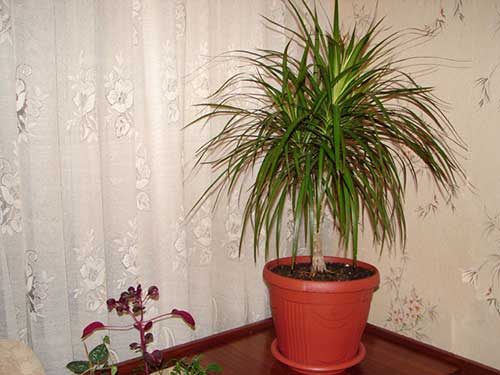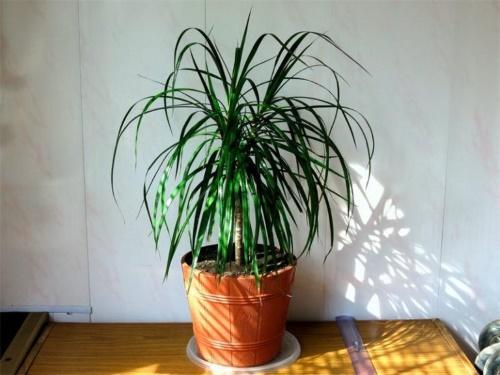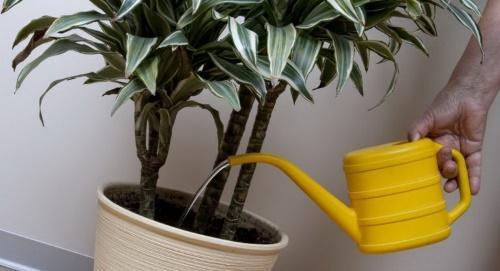How to care for dracaena at home: finding out the details
 Dracaena (photo) called a false palm tree for its external resemblance: the flower grows in the form of a tree. A young plant first has a lush rosette of long leaves. As it grows and matures, the lower foliage gradually dies off, due to which a bare trunk is formed. A lush leafy cap adorns the top of the trunk. To keep it as thick, it is important to know how to care for dracaena at home.
Dracaena (photo) called a false palm tree for its external resemblance: the flower grows in the form of a tree. A young plant first has a lush rosette of long leaves. As it grows and matures, the lower foliage gradually dies off, due to which a bare trunk is formed. A lush leafy cap adorns the top of the trunk. To keep it as thick, it is important to know how to care for dracaena at home.
In general, this is an unpretentious culture, which even inexperienced growers can grow. She has a minimum of requirements and in indoor conditions the flower feels quite comfortable. However, you can get a really lush palm tree by adhering to some recommendations regarding:
- the conditions for keeping the flower;
- the nuances of caring for him.
Let's dwell on each of them in a little more detail.
How much heat and light does dracaena need?
Although dracaena is a thermophilic culture, the heat has a depressing effect on it, especially during the rest period. The optimal temperature values in the room where the palm tree stands should be at the level of 18-26 degrees Celsius.
But in order for the dracaena to develop actively, it should be provided with rest from the end of autumn to the end of winter. This is easy to do: just move the flowerpot to relative coolness (no more than 18, but not lower than 14 degrees Celsius).
The sun dracaena loves and needs him all year round. The only caveat: no direct rays should fall on the leaves. They kill tissue by disfiguring the beautiful appearance of foliage. With a lack of lighting, the flower begins to stretch.
How to care for dracaena at home?
There are many varieties of dracaena, but the principles of caring for them are practically the same. All varieties love water and need shaping.
How to water?
Dracaena is demanding on moisture and with a lack of it, the tips of the leaves begin to dry out. At the same time, excess moisture leads to root rot. Thus, the flower should be watered as soon as the soil dries out from above, and preferably abundantly. In addition, excess water that has leaked into the sump must be drained. Naturally, watering will be less frequent in winter.
The leaves themselves need a shower, that is, a spray. This is especially important in the summer heat.
Do I need to feed?
Dracaena is developing quite well without top dressing, but it will not be superfluous to make them. Additional nourishment during active growth (spring-fall) will help the flower build a fuller head and awaken the buds after pruning.
It is enough to add a special mineral complex for dracaena or decorative leafy plants twice a month.
How to shape?
Dracaena independently branches reluctantly and often grows into a tall, but single-stemmed tree. You can get a beautiful crown from several stems by trimming... When a young palm tree gains a height of about 30 cm, it is necessary to mercilessly cut off the top. Sprinkle the cut itself with coal, you can wrap it with sphagnum or just put on a bag. After a while, the lateral buds will swell on the trunk.New stems will grow from them.
When to transplant?
Dracaena grows quickly enough, so young flowers need to be transplanted annually. For adult specimens, it is enough to carry out it once every three years. The best time to transplant is late winter - early spring. The flower is not picky about the soil.
Dracaena herself will make it clear that she is already cramped in the old pot: roots will begin to crawl out of its drainage holes.
Although the root system of the dracaena is superficial, the flowerpot for it must be taken large and deep enough, because the palm tree is heavy, therefore, shallow pot can overturn. In addition, there must be room in the container for a good drainage layer. It is easy to determine the size of a flowerpot by comparing the size of it and the flower. For every 15 cm of the height of the dracaena trunk, 5 cm of the diameter of the pot is needed. It is best to use sturdy pottery.